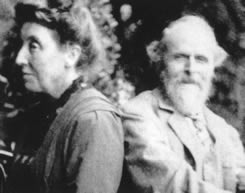|
The Love Potion
''The Love Potion'' is a 1903 painting by Evelyn De Morgan depicting a witch with a black cat familiar at her feet. According to Elise Lawton Smith,Elise Lawton Smith (2002)Evelyn Pickering De Morgan and the Allegorical Body(Fairleigh Dickinson University Press) the painting "exhibits a Pre-Raphaelite fascination with medieval subjects and decorative detailing." Analysis ''The Love Potion'' pushed the boundaries of society's expectations of women by "exploring the nature of female authority through the practice of sorcery". The painting differs from most of De Morgan's earlier works by featuring a sorceress as the subject, rather than a Christian or mythological figure. The sorceress is dressed in an ornate gold gown, which is symbolic of her mastery of skill and the final stage of the alchemical system of progression toward salvation. Her mastery is further evidenced by leather bound books on the shelf, which were popular alchemy texts during the late nineteenth century. The su ... [...More Info...] [...Related Items...] OR: [Wikipedia] [Google] [Baidu] |
Evelyn De Morgan
Evelyn De Morgan (30 August 1855 – 2 May 1919), née Pickering, was an English painter associated early in her career with the later phase of the Pre-Raphaelite Movement, and working in a range of styles including Aestheticism and Symbolism. Her paintings are figural, foregrounding the female body through the use of spiritual, mythological, and allegorical themes. They rely on a range of metaphors (such as light and darkness, transformation, and bondage) to express what several scholars have identified as spiritualist and feminist content. De Morgan boycotted the Royal Academy and signed the Declaration in Favour of Women's Suffrage in 1889. Her later works also deal with the themes of war from a pacifist perspective, engaging with conflicts like the Second Boer War and World War I. Early life She was born Mary Evelyn Pickering at 6 Grosvenor Street, to Percival Pickering QC, the Recorder of Pontefract, and Anna Maria Wilhelmina Spencer Stanhope, the sister of the art ... [...More Info...] [...Related Items...] OR: [Wikipedia] [Google] [Baidu] |
Potion
A potion () is a liquid "that contains medicine, poison, or something that is supposed to have magic powers.” It derives from the Latin word ''potus'' which referred to a drink or drinking. The term philtre is also used, often specifically for a love potion, a potion that is supposed to create feelings of love or attraction in the one who drinks it. Throughout history there have been several types of potions for a range of purposes. Reasons for taking potions ranged from curing an illness, to securing immortality to trying to induce love. These potions, while often ineffective or poisonous, occasionally had some degree of medicinal success depending on what they sought to fix and the type and amount of ingredients used. Some popular ingredients used in potions across history include Spanish fly, nightshade plants, cannabis and opium. During the 17th to 19th century, it was common in Europe to see peddlers offering potions for ailments ranging from heartbreak to the plague ... [...More Info...] [...Related Items...] OR: [Wikipedia] [Google] [Baidu] |
Paintings By Evelyn De Morgan
Painting is the practice of applying paint, pigment, color or other medium to a solid surface (called the "matrix" or "support"). The medium is commonly applied to the base with a brush, but other implements, such as knives, sponges, and airbrushes, can be used. In art, the term ''painting ''describes both the act and the result of the action (the final work is called "a painting"). The support for paintings includes such surfaces as walls, paper, canvas, wood, glass, lacquer, pottery, leaf, copper and concrete, and the painting may incorporate multiple other materials, including sand, clay, paper, plaster, gold leaf, and even whole objects. Painting is an important form in the visual arts, bringing in elements such as drawing, composition, gesture (as in gestural painting), narration (as in narrative art), and abstraction (as in abstract art). Paintings can be naturalistic and representational (as in still life and landscape painting), photographic, abstract, narrati ... [...More Info...] [...Related Items...] OR: [Wikipedia] [Google] [Baidu] |


